A fat bumble bee lumbered across the stern of our boat. He circled a few times before realizing the yellow rope and orange life preserver weren’t flowers, then turned and headed back to the island where we were anchored. A black and white Kingfisher crossed his path, gliding impossibly close to the blue-green water of the Nile. With each flap, the tips of his wings barely grazed the water. Rather than scattering the schools of silver fishes below, the disturbance caused them to jump. To their death. There is no escaping the aptly named Kingfisher.
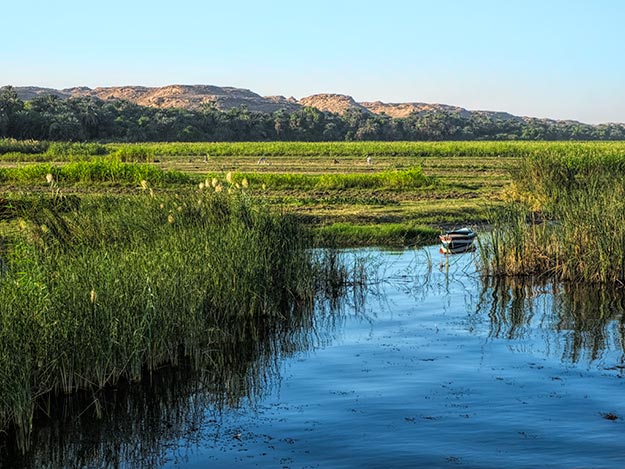
On the island, clumps of papyrus and water lilies with pale purple flowers dotted the marshes. Cattle roamed and munched on lush grasses, pausing every so often to low. Wild donkeys joined in, their braying a cross between a dog’s bark and a honking goose. The only other sounds were the gentle lapping of the Nile against the shore and twittering birds so numerous I couldn’t catalog them.
Three days earlier I had boarded the El Nil, one of four traditional houseboats designed and purpose built by Nour El Nil for their Dahabiya cruises on the Nile River. On the mahogany deck, overstuffed sofas, futons, and chairs begged to be occupied. Below decks, 10 luxurious cabins provided for an intimate group of no more than 20 passengers. I hopped up into my oversized queen-size bed, sank into the plush duvet and pristine white linens, and sighed with contentment.
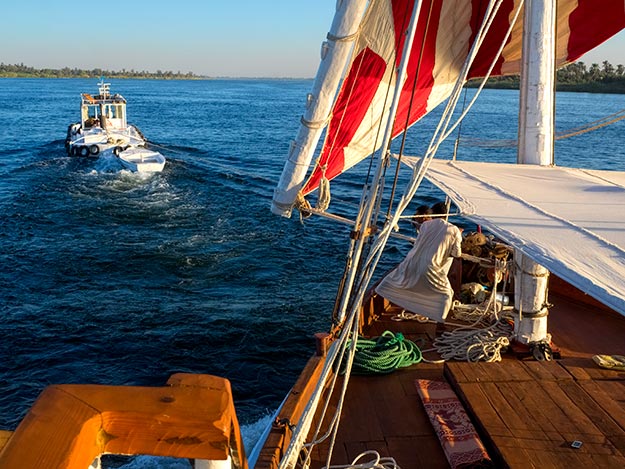
The tugboat that would accompany us for the entire journey soon towed us away from the dock and I hurried back up on deck to watch. In the middle of the Nile, our crew unfurled the front and rear sails, revealing majestic red and white stripes. When they caught the wind and billowed, our tug dropped the tow rope and we were off, powered solely by the wind!

For the next five days we sailed majestically up the Nile, with an occasional tow whenever we wandered too close to shore. Every so often we tied up at villages to have tea with local families or take short walks to archeological sites. On day two we stopped to visit one of the oldest settlements of Upper Egypt. Located just half a mile from the present-day village of El Kab, the elaborately decorated El Kab tombs were constructed for nobles from the new kingdom: Paheri, Setau, Aahmes, son of Abana, and Renni.

A short distance away, our local guide led us through an opening in a 30-foot high mud-brick wall that once encircled the ancient city of Nekheb. Today, two crumbling structures and a sacred lake are all that remain of the place that was once the capital of Upper Egypt. Back in the village, local children lay in wait. They surrounded us and thrust handmade baskets made from discarded candy wrappers under our noses, hoping for a sale. Sites like these are never seen by passengers aboard the behemoth cruise ships that ply the Nile. They are simply too big to tie up at the smaller docks.

Later that afternoon, El Nil docked in Edfu. I climbed into a charming but rickety horse-drawn carriage for the ride to the Temple of Horus, the second largest temple in Egypt after Karnak Temple in Luxor. Built between 237 and 57 BC, it is dedicated to the Falcon-headed god, Horus. Beyond two magnificent stone falcons that guard the entrance, a stunning carving portrays one of the most important events of the year, the Festival of the Beautiful Meeting. Each year during the harvest season the wife of Horus, Hathor, sailed more than 100 miles south in her sacred barque to be reunited with her husband. The wall relief shows Horus’ barque towing Hathor’s to the temple in preparation for harvest rituals. Deeper within the sanctuary, a small chapel contains a modern reproduction of the barques which Horus and Hathor might have used.
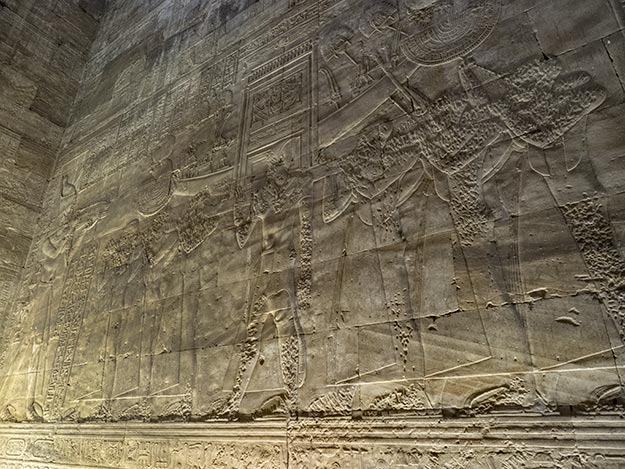
Though the archeological sites we visited were fascinating, for me that third day was the most remarkable of the cruise. A profound peace settled upon me as I sat cross-legged on the stern. Some of our group followed footpaths through the fields or enjoyed a dip in the fabled Nile. Others, like me, just relaxed and allowed the serenity to sink in. Later that evening, we sat around the dinner table and watched as dozens of enormous cruise ships sailed past on their three-day rush to Aswan. “What a nightmare,” one of us finally said. “Thank god I chose a cruise on a Dahabiya,” added another.

The ubiquitous carvings of Dahabiyas found in Egypt’s ancient temples and tombs testify that these twin-masted, flat-bottom vessels have been around for thousands of years. Originally used to carry royalty, Dahabiyas were the understandable choice when Nile cruises became de-rigeur for celebrities and the ultra-rich during the 19th century. By the beginning of the 20th century, however, steamboats and railroads were offering more comfortable modes of travel and Dahabiya use went into decline. Two world wars and the Great Depression sounded the death knell for expensive travel in general, and the Dahabiyas specifically. By the time travel once again became popular, large modern cruise ships had taken over the market.
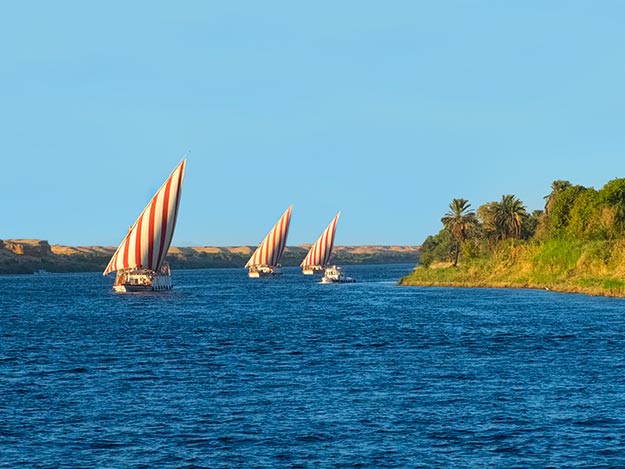
Enter Nour El Nil, founded in 2008 by three international entrepreneurs who had a vision to restore Dahabiya cruises on the Nile. Enrique Cansino, who was born in Mexico and later emigrated to the U.S. and Egypt, along with his partner, Eleonore Kamir, joined forces with Egyptian boat-maker Memdouh Sayed Khalifa. During his more than 30 years sailing the Nile, Memdouh had been saving the original fittings each time a boat was dismantled. Today these authentic fixtures adorn the four Dahabiyas that have been authentically reproduced by Nour El Nil.
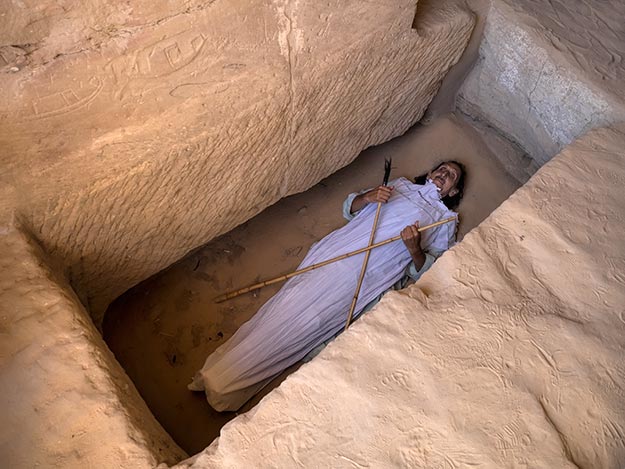
The elegant decor on the barges is the work of Eleonore, a French decorator by trade. And Enrique is, for lack of a better description, the chief inspirer, who breathed life into every site we visited. One day, he sneaked off ahead of our tour of a sandstone quarry that provided building materials for the ancient tombs. Our path led past a deep stone grave that illustrated burial practices at the site. When we peered over the edge, Enrique lay prone, crossed wooden staffs grasped in his fists. It was almost more of a shock when he opened his eyes and grinned up at us.

The crew was no less merry. I never tired of watching their white gallibayas billowing in the wind as they expertly handled the ship’s intricate rigging, or listening to their happy chatter when they sat together on the bow to share a meal. When they weren’t attending to the captain’s melodious Arabic commands, they were seeing to our every need, and always with a smile.
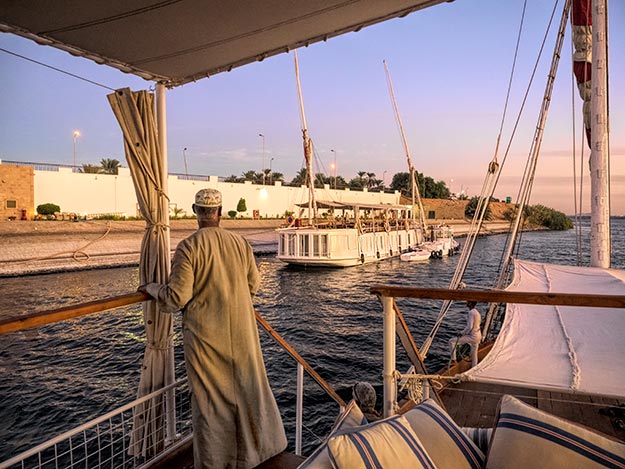
We put in below the Aswan Dam at sunset on day five. I knew my time aboard the El Nil would end the following morning, but I simply couldn’t deal with the idea of leaving. Instead, I focused on the huge amber moon rising over the nearby sand hills. It is said that a full moon is the time to let go of things, in order to make room for new. I had done that during my Nour El Nil cruise. Gone was the stress of meeting deadlines and making travel arrangements. Even my persistent neck and shoulder pains had ceased. My Dahabiya cruise on the Nile River had been nothing less than a rebirth.
Disclosure: My Nile River Cruise was partially hosted by Nour El Nil Cruises. However, the receipt and acceptance of complimentary items or services will never influence the content, topics, or posts in this blog. I write the truth, the whole truth, and nothing but the truth.

We are taking this cruise in about a month and I’m glad to hear you had a wonderful time. My parents immigrated to the U.S. from Egypt in the late 60’s and I have loved going back through the years. This is our first dahabiya cruise and we are very much looking forward to it!
I’m sure you will love it Wally. I thought it was a spectacular experience.
What a great experience ! Definitely putting this on my bucket list.
It’s definitely a good one to put on your list, Ann. Glad you enjoyed my story.